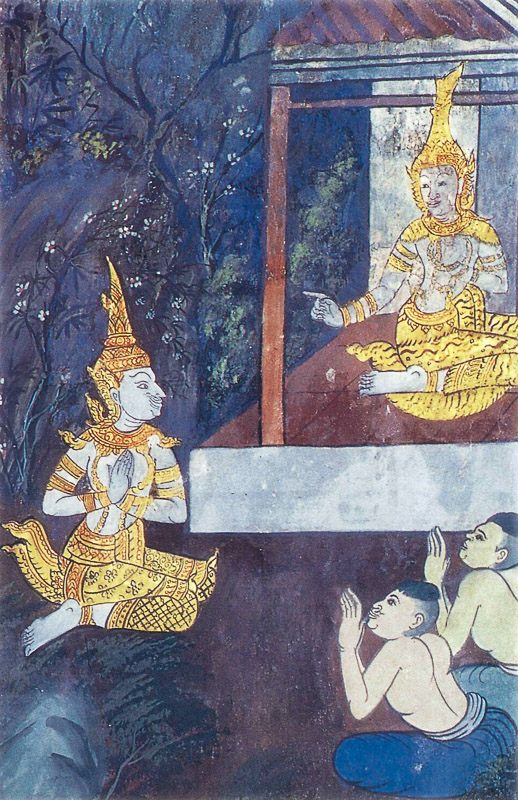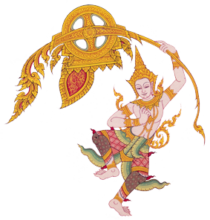
The Bodhisatta was once an ascetic. His father was the royal chaplain, and on the day the Bodhisatta was born, the sky foretold he would grow up to become the best archer in all of India. The prophecy came true, and when he came of age, he was hired to serve the king, earning a salary of one thousand coins per day. The king’s advisors were offended and suggested the king should not pay him so much without having ever seen him shoot. So, by the beat of a drum, the king summoned everyone in the city to come watch the Bodhisatta demonstrate his skill.
The Bodhisatta put on a splendid coat of armor and a jeweled crown and had four renowned archers (they were able to shoot as quick as lightning, split a hair, hit a target by sound rather than sight, and hit a falling arrow) stationed at the corners of a pavilion. The Bodhisatta stood in the center and told them to try their best to shoot and wound him, but he dodged all their arrows and shot the four men, making them drop to the ground. He called this trick the arrow-defense, and the crowd shouted and danced in applause and threw money and jewelry to him.
The delighted king wanted to see more, so the Bodhisatta put a plantain at each corner of the pavilion and shot all four with a single arrow; he called this the pierced-circle trick. Then he performed ten more tricks that nobody else in the world could do: the arrow-stick, arrow-rope, arrow-plait, arrow-terrace, arrow-pavilion, arrow-wall, arrow-stairs, arrow-tank, arrow-lotus, and arrow-shower. After these twelve displays of skill, the Bodhisatta gave nine demonstrations of strength: he shot arrows that pierced through a plank of fig wood twenty centimeters thick; a plank of asana wood ten centimeters thick; a copper plate five centimeters thick; an iron plate two and a half centimeters thick; a hundred boards joined together; a wagon full of straw, sand, and planks from the front; then again the same wagon from the back; two hundred meters of water; and four hundred meters of earth. At sunset, he finished his exhibition by piercing a hair from two hundred meters. The king rewarded the Bodhisatta with one hundred thousand coins and promised to appoint him commander-in-chief. But because it was late, they would do the ceremony the next day.
That night the Bodhisatta pondered his life and knew that power, a family, and wealth would cause him too much temptation and lead him on a path to hell, so he snuck off to a forest and became an ascetic. When Indra, king of the gods, saw this, he sent Vissakamma, heaven’s chief builder, to construct a monastery for the Bodhisatta and the multitude he knew would soon follow him. There the Bodhisatta lived on roots, berries, and other foods he gathered in the forest and soon developed the eight attainments and five supernatural faculties.
Eventually the king learned of the Bodhisatta’s whereabouts and went to visit him. The Bodhisatta floated in the air and preached to him and his entourage about dharma and the misery caused by sensual desires. After listening, they all renounced the world on the spot and stayed in the forest with him.
As time went on, word about the Bodhisatta spread and thousands more came to live the ascetic life alongside him. The monastery became overcrowded, so he sent six of his best students (a seventh stayed behind with him), each with a company of ascetics, out to settle in other places. One of these, Kisavaccha, made his home in a king’s royal park outside the palace.
A formerly respected courtesan of the king in whose park Kisavaccha settled had just been fired, and she was very disappointed. Seeing Kisavaccha in the park, she assumed he was cursed with bad luck and thought she could use him to get rid of hers. She spat a toothpick and a blob of phlegm into his matted hair, and then went to bathe. Soon after, the king reconsidered and gave her back her job. She was convinced this was due to her little ritual with the ascetic, and when the king later sacked his chaplain, she told him what to do to get his job back. He followed her advice exactly, and was reinstated soon after.
When there was a rebellion in a border region, the chaplain recommended the king get rid of any bad luck before heading off to fight by spitting in Kisavaccha’s hair, and he took the entire army to do so with him. The commander-in-chief came to the park last, but he did not spit; instead, he removed the toothpicks from Kisavaccha’s hair and helped him wash. He asked Kisavaccha what would happen to the king because of his bad behavior. Kisavaccha said that while he himself harbored no anger, the gods were furious about people disrespecting a holy man, and the entire kingdom would be destroyed in seven days. The commander-in-chief warned the king and then fled with his family. Kisavaccha also left, but due to the king’s abuse, he died soon after returning to the Bodhisatta’s monastery. People came from far and wide for his funeral, and flowers fell from heaven during the cremation.
The king didn’t believe the prediction of impending doom and went off to battle as planned, successfully defeating the rebels. He returned to the capital with his prisoners. On the seventh day, the gods made it rain, and a flood washed away all the dead bodies. The rain changed to flowers, and then to coins and gold jewelry, and everyone was happy. Then the rain became all manner of blazing weapons, and people were cut up piecemeal. The weapons were followed by burning embers, blazing mountain peaks, and fine sand, leaving the whole kingdom in utter destruction.
When three neighboring kings heard about this, they wanted to know where the annihilated king and others who had suffered a similar fate for mistreating holy men (including the king who killed the Bodhisatta in the Khantivadi Jataka (#313)) were reborn. So they traveled to the Bodhisatta’s monastery to ask. At the same time, Indra, pondering seven questions, descended from heaven on the back of his thirty-three-headed elephant, Airavata, and joined the kings to get answers from the Bodhisatta.
The Bodhisatta confirmed the kings’ assumption that those who had sinned against holy men went to hell. Then he answered many questions about patience, wisdom, and righteousness, and the three kings overcame their cravings for pleasure and were filled with bliss. Now endowed with supernatural powers, the kings flew back to their homes, as did a satisfied Indra.
In the Lifetime of the Buddha
Kisavaccha was an earlier birth of Moggallana, one of the Buddha’s top disciples. Moggallana had the power to visit heaven and hell, and when he did, he told people on earth that he had seen disciples of the Buddha living in bliss in heaven and followers of other religious leaders suffering in hell. Because of this, the heretics lost much support, and they paid a bandit one thousand coins to kill Moggallana. When Moggallana saw him coming, he flew away to safety. The bandit came back day after day, and Moggallana escaped each time. But on the seventh day, Moggallana’s powers vanished and the bandit crushed all his bones. (Moggallana lost his powers due to a time in a past life when he severely beat his elderly parents. He intended to kill them, but was overcome with guilt and stopped before they died.) With his last bit of strength, Moggallana flew to see the Buddha, and he died at the monastery. There was grief over his death on earth and in heaven, and flowers rained down during his cremation. The Buddha hosted a sacred festival in Moggallana’s honor, attended by men and gods, that lasted seven days.
When the Buddha later heard some of his disciples discussing how Moggallana had received great honor after his death because he died in the presence of the Buddha, but Sariputta, a disciple of the Buddha as accomplished and revered as Moggallana, who had died two weeks earlier in the village where he had been born, did not, he told them this story so they knew that he had also given Moggallana great honor after a death in the past; and that it had also rained flowers during that cremation.
Five of the Bodhisatta’s other best students were earlier births of five of the Buddha’s top disciples: Sariputta, Maha Kassapa, Anuruddha, Maha Kaccana, and Ananda.
